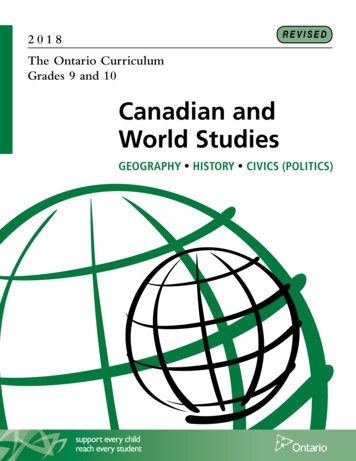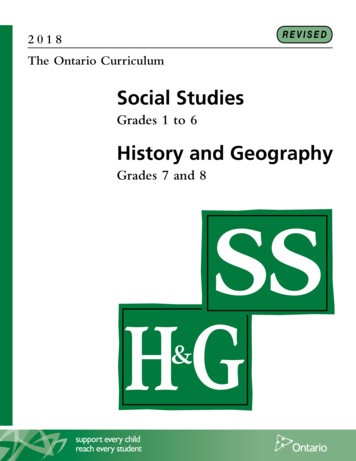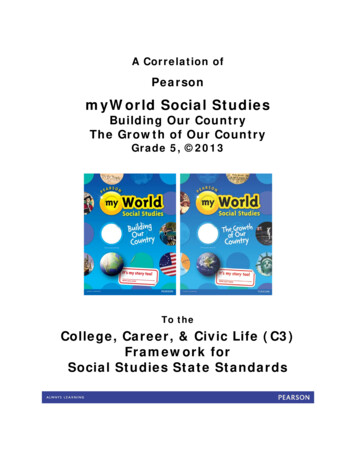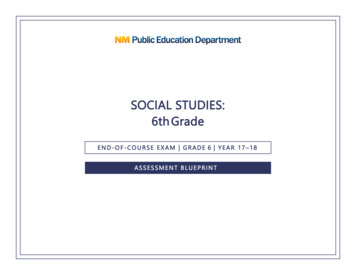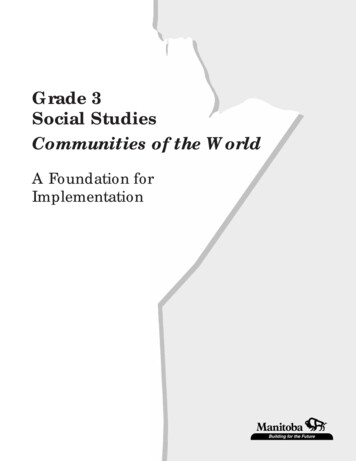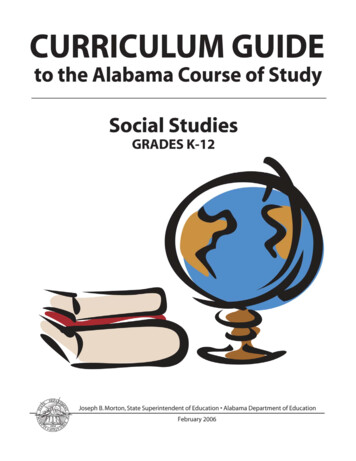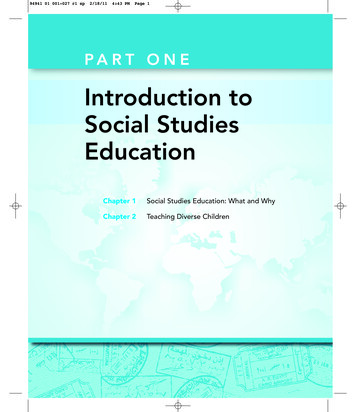
Transcription
DIOCESE OF TUCSONDEPARTMENT OF CATHOLIC SCHOOLSSOCIAL STUDIES STANDARDSGRADES K-5June 20171
TABLE OF CONTENTSAcknowledgements .3Framework 4Competency Skills 5Progression Map 7Kindergarten .8Second Grade 11Third Grade .13Fourth Grade .15Fifth Grade .172
ACKNOWLEDGEMENTSThe Diocese of Tucson Department of Catholic Schools wishes to express ourgratitude to the Social Studies Standards Committee for its work in revising andupdating the K-8 Social Studies Standards:Tanya BullardLourdes Catholic SchoolNogalesFrances ColungaSacred Heart Catholic SchoolNogalesKresta LealSaints Peter & Paul Catholic SchoolTucsonNicole PickettImmaculate Heart SchoolOro ValleyJessica HerediaSacred Heart Catholic SchoolNogalesWill RussellSt. Augustine Catholic High SchoolTucsonDiane KopfSt. Anthony Catholic SchoolCasa GrandeAmanda SageSaints Peter & Paul Catholic SchoolTucsonMichelle BuhsInstructional Support CoordinatorDepartment of Catholic SchoolsThe Standards Committee recognizes with gratitude the following dioceses forsharing their social studies standards work which served as inspiration behind thisCommittee’s revision of the Diocese of Tucson Social Studies Standards:Diocese of PhoenixArchdiocese of CincinnatiArchdiocese of PortlandInterdiocesan Curriculum Committee, New York3
FRAMEWORKThe goal of the Social Studies Standards Committee was to create a course of studythat will prepare students to be 21st century citizens through gaining anunderstanding of how the actions of people throughout history have created andsolved social, economic, and global problems, and developing the ability to thinkcritically and logically. The standards are intended to provide the classroom teacherwith identifiable and measurable objectives that are developmentally appropriatefor each grade level. Teachers are encouraged to take an interdisciplinary approachin teaching social studies. Content can be integrated with other subject areasthrough lesson planning and unit development to provide a practical and applicableunderstanding of the social studies strands.The themes of Catholic Social Teaching are embedded throughout the standards toemphasize the goal of global awareness as Catholics. These teachings are based onthe belief that God’s plan for creation is to build his kingdom of peace, love, andjustice. Catholic Social Teaching touches on many aspects of students’ lives, suchas the family, caring for creation, rights of workers, serving the poor and vulnerable,and the dignity of the human person. Students will reflect on the realities ofmodern life in relation to these principles that are rooted in Gospel values.Standards Coding: The Social Studies Standards in grades K-5 include four strands:History (H), Geography (G), Government (GOV), and Economics (E). Each standardis marked with the appropriate grade level, strand, and identifying standard withinthe strand.Example: 5.G.3 translates to Grade 5, Geography strand, standard 3.4
K-5 COMPETENCY SKILLSThere are six Competency Skills (CS): Investigation, Visual Data, Historical Americans andTraditions, Citizenship, Catholic Identity, and Current Events. These are skills that should betaught in the context of the Social Studies Standards, in a developmentally appropriate format ateach grade level. It is recommended that teachers discuss the teaching of these skills inProfessional Learning Communities (PLC’s), with the goal of vertical alignment in thedevelopment of these skills. The General Competencies should be embedded in lesson planning,and unit development.CS.1. InvestigationUse primary sources to research and study people and events of the past.CS.2 Visual DataStudy, develop, and interpret geographic and historic information using: TimelinesMaps (political, physical, climate, resource)o a. titleo b. compass rose (cardinal and intermediate directions)o c. symbolso d. legendo e. scaleo f. road map indexo g. grid (latitude and longitude)(Progressing each year in age-appropriate fashion)GlobesChartsGraphsCS.2aUse different types of maps to solve problems: (i.e. road maps-distance, resource mapsproducts, historical map-boundaries, thematic maps-climate.CS.3 HistoricalAmericans and EventsRecognize the significance of American individuals and events, as they contributed to ournation’s history including:Susan B. AnthonyJackie RobinsonRosa ParksMartin Luther King, Jr.Cesar ChavezChristopher ColumbusLeif EricsonCS.4 CitizenshipJohn GlennNeil ArmstrongSally RidePresident’s DayVeteran’s DayMemorial Day9/11Describe the rights and responsibilities of citizenship:5
CS.5 Catholic IdentityDescribe the rights and responsibilities of individuals as God’s creation. CS.6Current EventsIdentify and discuss the possible consequences of violating rules and laws.Elements of fair play, good sportsmanship, and the idea of treating others theway you want to be treated.Importance of participation and cooperation in a classroom and communityResponsibility of being involved in the democratic process (voting, civil andcommunity service, volunteering)Discuss the importance of and participate in community service as a response orcall to live out our faith.Identify ways students can have an impact on their local parish community.Use information from written documents, oral presentations, media, and the internet todiscuss current events. Include geographic knowledge and skills as they relate to currentevents.6
K-5 PROGRESSION MAP FOR AMERICAN SYMBOLS & TRADITIONSThe Progression Map provides recognition indicators for each grade level ofsymbols and traditions that reflect our American heritage. These indicators shouldbe taught in the context of the Social Studies Standards. They ensure that studentsdevelop an understanding of the importance and meaning of the signs and symbolsthat represent our country.Kindergarten 1st Grade 2nd Grade 3rd Grade 4th Grade 5th Grade Identify and recognize the American Flag and the Statue of Liberty.Recite the Pledge of Allegiance.Identify the following people:a) Current President of the United States.b) George Washingtonc) Abraham LincolnIdentify and recognize: Bald Eagle, The White House, and TheWashington Monument.Identify and recognize the state flag of Arizona.Know who the President of the United States is and his role.Identify and recognize the Liberty Bell and the US Capitol.Understand the meaning of the American Flag (what the stars andstripes mean).Understand the meaning of the Pledge of Allegiance.Learn the National Anthem and “America the Beautiful.”Recognize local, church, state, and national leaders such as themayor, governor, and presidentExplain the significance of Ellis Island, the Statue of Liberty, theLincoln Memorial, and the US Capitol.Identify the governor of Arizona and their role.Understand the meaning of Arizona state flag.Understand proper etiquette for care and handling of the Americanflag.Recognize National Landmarks throughout the country.Recognize the Seal of the United States.7
KindergartenA Child’s Place in the Family, Catholic Church, and CommunityStudents will begin to understand rules and the responsibilities of living and working together.They will develop an awareness of history, cultural heritage, and Catholic raphyK.G.1K.G.2K.G.3K.G.4K.G.5K.G.6K.G.7Identify religious, family and cultural celebrations and traditions as a way ofremembering and honoring people, events and heritage.Identify yesterday, today, tomorrow, the days of the week and months of theyear.Introduce the interaction of Native Americans with the Pilgrims.Relate history to personal experiences (e.g., when I was little)Recognize that families have a history of past members, events, and customs(i.e., religion, Catholic Traditions).Develop an awareness and respect of different cultures.Recognize the differences and similarities of maps and globes.Identify land and water on maps, illustrations, images and globes.Construct simple maps and models of neighborhoods, incorporating suchfeatures as police and fire stations, airports, banks, hospitals, supermarkets,schools, homes, churches, etc.Use basic directions (relative location) such as up, down, left, right, near, far.Recite address: city, state, and phone number.Locate Arizona on a map of the United States.Explain how people can care for the environment and show respect for God’screation.GovernmentK.GOV.1Use and identify respectful dialogue, taking turns, and explain how rules aredifferent in different settings.K.GOV.2Begin to recognize how voting can be used to make group decisions.K.GOV.3Identify community helpers and authoritative figures at home, school, andcommunity.EconomicsK.E.1K.E.2K.E.3K.E.4Discuss differences between needs and wants.Discuss different types of jobs that people do.Match simple descriptions of work with the names of those jobs (includingreligious vocations).Give examples of work activities that people do at home.8
First GradeA Member of Families, Catholic Church, Communities, and the CountryFirst graders will build an understanding of their role as members of families, the Catholicchurch, communities, and countries by exploring history, culture, and .51.G.61.G.7Begin to identify famous people in American history.Recognize that explorers (e.g. Columbus, Padre Kino and Spanish Missionaries)traveled to places that were new to them.Commemorate American historical events (e.g., 9/11, Veteran’s Day, ColumbusDay)Identify different cultures through the study of holidays, customs, and traditions(e.g., Dia de Los Muertos, All Souls Day)Distinguish events or stories as past, present, or future.Recognize that the development of farming allowed groups of people to settle inone place and develop into cultures/civilizations (e.g., Ancestral Puebloans(Anasazi), Hohokam, Moundbuilders, Aztec, Mayan)Recognize that settlement led to the development of farming techniques,government, art, architecture, and communication in North America.Describe the interaction of Native Americans with the Spanish, the Pilgrims, andthe Colonists.Compare the way people lived in Colonial times with how people live today (e.g.,housing, food transportation, school).Begin to recognize cultural backgrounds of families, their roles, and how familiescontribute to communitiesLearn basic directions such as north, south, east, and west.Recognize that maps and globes represent real places, symbols stand for realobjects.Construct a simple map using cardinal directions and map symbols.Locate Arizona and the local community on a map of the United States.Discuss how land in the students’ community is used for industry, housing,business, agriculture, and recreation.Describe how location, weather, and physical environment affect the way peoplelive, including the effects on their food, clothing, shelter, transportation, andrecreation.Study how we as Catholics are called to service within our community and toserve those who are in need in our community.Government1.GOV.1Recognize the need for rules and laws in our community, home, school, andcountry1.GOV.2Identify examples of responsible citizenship in the school setting and in storiesabout the past and present.1.GOV.3Discuss the importance of students contributing to a community as Catholics(e.g., helping others, working together, cleaning up the playground).9
Economics1.E.11.E.21.E.31.E.41.E.5Discuss the difference between basic needs and wants in everyday life andwithin our families.Recognize that people need to make choices because of limited resources.Recognize that some goods are made locally and some are made elsewhere.Recognize that people are buyers and sellers of goods and services.Describe how people earn a living in the community and the places they work.10
Second GradeCommunities, Culture, and CitizenshipSecond graders will develop an understanding of different types of Communities and the rolespeople play within the community. They will learn basic map skills and begin to study the historyof America. The students will expand their knowledge of various cultures, and learn what itmeans to be a .G.72.G.82.G.9Recognize Native-American cultures and civilizations and how they changedover time.Recognize American colonists and Native American groups lived in the areas ofthe thirteen colonies that was ruled by England.Recognize the colonists’ dissatisfaction with England's rule as a key issue thatled to the Revolutionary War. (Religious Freedom)Recognize that the United States became an independent country as a result ofthe Revolutionary War.Introduce the creation of the Constitution and Bill of Rights as the foundation ofour government. (One Nation Under God)Identify reasons for immigration to the United States.Identify reasons why Americans moved West to territories or unclaimed land.Discuss the experiences of the pioneers as they journeyed west to settle newlands (e.g., new forms of transportation, communication, etc.)Discuss the effects of Westward Expansion on Native Americans. (Including theimpact of the Spanish Missionaries)Use the North and South Poles and Equator as reference points to locate theUnited States and other places on a map.Introduce and discuss physical features/landforms (e.g., mountains, rivers,deserts, islands, plateaus, etc.).Construct a map of a familiar place that includes a title, compass rose, symbols,and physical features.Locate other countries or communities on a map or globe as they are studied inthe social studies curriculum in other subject areas.Differentiate between urban, suburban, and rural settings.Discuss the major economic activities and land use (e.g., natural resources,agricultural, industrial, residential, commercial, recreational) of areas studied.Describe elements of culture (e.g., food, clothing, housing, sports, customs,beliefs) in a community of areas studied.Recognize the connections between city, state, country, and continent.Recognize ways of becoming good stewards of Earth’s natural resources.Government2.GOV.1Recognize that despite cultural differences, Americans share common principles,goals, customs and traditions.2.GOV.2Introduce the three branches of national government as represented by thePresident, Congress, and the Supreme Court.11
1Understand people vote to put leaders in office for a determined amount of time.Recognize how Arizona and the other states combine to make a nation.Explain the concept of a democracy.Identify rules that help people work and live in society.Identify traits of character: (e.g., honesty, courage, cooperation and patriotism)that are important to the preservation and improvement ofcommunity/democracy.Determine how people make choices to spend their earnings on needs andwants.Discuss how opportunity cost occurs when something must be given up.Identify differences among natural resources (e.g., water, soil, and wood), humanresources (e.g., people at work), and capital resources (e.g., machines, tools andbuildings).Recognize that people trade for goods and services.Compare the use of barter and money in the exchange for goods and services(e.g., trade a toy for candy, buying candy with money).Recognize that some goods are made in the local community and some aremade in other parts of the world.Discuss how people can be both producers and consumers of goods andservices.Identify jobs that provide goods and services for communities.Identify that jobs provide income for families.Explore various professions, jobs, religious vocations, and volunteer services incommunities.Discuss costs and benefits of personal savings (including charitablecontributions).12
Third GradeHistory Through People and PlacesThird graders will examine and evaluate history through the influences that people and placeshave had over time, and develop and utilize map 33.G.43.G.53.G.63.G.73.G.83.G.9Identify reasons for forming of a community.Recognize how natural resources impact the founding of communities.Identify changes that take place within communities over time.Recognize conflicts and resolutions within communities.Identify communities of long ago and compare them to modern communities.Discuss technological advances in transportation and communication thatfacilitated exploration of the New World and today.Recognize that European countries explored the New World for economic andpolitical reasons.Introduce European explorers (e.g., Samuel Champlain, Henry Hudson, JohnCabot, Jacques Cartier, Ponce de Leon, Hernando de Soto, Columbus,Magellan, Vasco da Gama, Balboa) and their discoveries in the New World.Recognize the causes and issues for the Civil War (e.g., slavery, states’ rights,South seceded from the Union).Discuss contributions of people during the Civil War era (e.g., Abraham Lincoln,Jefferson Davis, Robert E. Lee, Ulysses S. Grant, Harriet Tubman, FrederickDouglas).Discuss reasons why people left their home country to start a new life in theUnited States (e.g., famine, political discord, religious persecution, economicopportunity).Describe the experiences (e.g., new language, customs, opportunities,hardships) in immigrants’ lives after settling in the United States during the late19th and early 20th centuries.Explain the purpose of physical and political maps.Locate the Equator, Prime Meridian, Arctic Circle, Antarctic Circle, North andSouth Poles, and Northern and Southern Hemispheres on maps and globes.Recognize characteristics of physical features and locate them using maps,illustrations, images, or globes (four oceans, seven continents, river, lake, bay,mountain, plateau, coast, desert, plain, valley, volcano, peninsula, island, etc.).Recognize characteristics of human features and locate them using maps,illustrations, images, or globes (city, state, country, roads, railroads).Construct a map that includes a title, compass rose, symbols, legend, a scale,physical and human features.Identify the regions of the United States.Describe changes over time in transportation (e.g., animal, boat, train, motorizedvehicle, aircraft).Describe changes over time in communication networks (e.g., telegraph,telephone, postal, internet).Describe elements of culture of a community or nation (e.g., food, clothing,housing, sports, customs, beliefs) in areas studied.13
3.G.10Describe economic features of a community that make it a distinctive place(landforms, climate, human and animal populations, and natural resources).Government3.GOV.1Identify and explain the roles and responsibilities of the three branches of stateand national government: a. Executive b. Legislative c. Judicial3.GOV.2Recognize the value of government within a community.3.GOV.3Recognize that there are different levels of government (e.g., school, local, tribal,county, state, national)3.GOV.4Identify the basic concept of how laws are made (e.g., law proposed, discussed,amended, voted on).3.GOV.5Identify character traits (e.g., honesty, courage, cooperation, respect,trustworthiness, responsibility, citizenship) that are important to the preservationand improvement of .E.53.E.63.E.7Define the terms bartering/trading and identify their value to the growth of acommunity.Identify the production of goods in various communities.Identify how scarcity requires people to make choices due to their unlimitedwants and needs.Identify opportunity costs in personal decision-making situations.Discuss reasons (e.g., labor, raw materials, energy resources) why some goodsare made locally and some are made in other parts of the United States andworld.Discuss different ways individuals can earn money.Discuss costs and benefits of personal spending and saving choices (includingcharitable contributions).14
Fourth GradeArizona and Regions of the United StatesThe state of Arizona is the focus for grade four including its geography, history, government, andeconomy. Students also identify the geography and characteristics of U.S. regions.History4.H.14.H.24.H.34.H.44.H.5Explain the history of the regions of the U.S.Determine the impact that various nationalities have had on the U.S.Understand and value different ethnicities and cultures.Describe the political and economic reasons (e.g., trade routes, gold) for Spanish,English, French, and Portuguese explorations of the Americas.Formulate Christian attitudes toward conflict resolution.Arizona History4.AH.1Describe the legacy and cultures of prehistoric people in Arizona (Mogollon, AncestralPuebloans (Anasazi), and Hohokam)4.AH.2Identify other groups (e.g. Patayan, Sinagua, Salado) residing in the Southwestduring this period.4.AH.3Describe the reasons for early Spanish exploration of Mexico and the Southwesternregion of the United States. (Cabeza de Vaca, Estevan, Fray Marcos de Niza,Francisco Vásques de Coronado, and Cardenza).4.AH 4Describe the impact of Spanish colonization on the Southwest (missions, FatherKino).4.AH.5Describe the location and cultural characteristics of Native American tribes (e.g.,O’odham, Apache, Yaquis, Navajo, Hopi) during the Spanish period to present day.4.AH.6Analyze and list the reasons for the influence of early American explorers in AZ.4.AH.7Introduce the Mexican War and its effects on AZ.4.AH 8Recognize the change of governance of the Southwest from Spain to Mexico as aresult of the Mexican Revolution.4.AH.9Describe the influence of American explorers and trappers (e.g., James O. Pattie, KitCarson, Bill Williams) on the development of the Southwest.4.AH.10Describe events that led to Arizona becoming a possession of the United States:a. Mexican – American Warb. Mexican Cession (Treaty of Guadalupe Hidalgo)c. Gadsden Purchase4.AH.11Describe the conflict of cultures that occurred between settlers and Arizona NativeAmericans:a. Indian Warsb. Navajo Long Walkc. Arizona becomes a territory4.AH.12Describe the impact of Native Americans, Hispanics, and settlers on the culture ofArizona (e.g., art, language, architecture, mining, ranching).4.AH.13Describe events in Arizona during the Civil War:a. Battle of Picacho Peakb. Battle of Apache Passc. Arizona becomes a territory4.AH.14Describe the economic development of Arizona: a. mining b. ranching c. farming anddams/irrigation d. tourism4.AH.15Describe the impact of innovations in transportation (e.g., steamboats, freighting,stagecoaches, railroads) that helped Arizona’s growth and economy.4.AH.16Identify key individuals and groups (e.g., Charles Poston, Sharlot Hall, BuffaloSoldiers, Geronimo, George W.P. Hunt, Manuelito, Cochise, Jack Swilling) related toArizona's territorial days and early statehood.15
.AH.24Describe Arizona’s transition from territory to statehood:a. locations of state capitalb. founding people.Recognize that Arizona changed from a territory to a state on February 14, 1912.Recognize the formation of Native American communities and reservations in Arizona(e.g., Gila River Reservation, Yaquis, Colorado River Indian Tribes).Define reservations and analyze reasons for existence of reservations in Arizona.Describe the impact of World War II on Arizona and its inhabitants (e.g., economicboost, military bases, Native American, Navajo code talkers, and Hispaniccontributions, POW camps, relocation of Japanese Americans; e.g., limited goods,women worked in factories, increased factories, increased patriotism).Describe changes in Arizona (e.g., population growth, economic growth, culturaldiversity, civil rights) that have taken place since World War II.Describe the influence of key individuals in Arizona (e.g. Sandra Day O’Connor, CarlHayden, Ernest W. McFarland, Barry Goldwater, Cesar Chavez, Morris Udall, andRichard Carmona).Recognize the Catholic influence on Arizona history.Arizona Government4.AGOV.1Identify and explain the functions of each branch of Arizona’s state government(recognize tribal governance).4.AGOV.2.Analyze and understand the importance of Arizona symbols (e.g., seal, flag, the “5C’s”, [cotton, climate, cattle, copper, and citrus]).4.AGOV.3Identify the rights and freedoms supported by the following documents:a. Preamble of the U.S. Constitutionb. Bill of Rightsc. Statement of Natural Rights as found in the Declaration of Independence(We hold these truths to be self-evident ).4.AGOV.4Identify traits of character (e.g., responsibility, respect, perseverance, loyalty,integrity, involvement, justice and tolerance) that are important to the preservationand improvement of community/democracy.Geography4.G.1.4.G.2Explain how climate, physical features and resources contributed to the settlement,economic activity, and movement within each geographic region of the United States.Name and locate states, their capitals, and abbreviations.Arizona Geography4.AG.1Use maps to locate major physical and human features of Arizona including: GrandCanyon, Mogollon Rim, Colorado River, Gila River, and Salt River, bordering states,past/present capitals of Arizona, other major cities in Arizona.4.AG.2Locate, identify, and compare the regions of Arizona (plateau, mountain, and desert)including physical features and characteristics.4.AG.3Locate Arizona counties in which major cities are e the law of supply and demand.Identify how natural resources affect the growth of different regions.Understand how regions are dependent on each other economically.Describe why state and local governments collect taxes. (e.g., schools, fire, police,libraries).Introduce profit as an incentive to entrepreneurs.16
Fifth GradeEarly American Peoples through the Revolutionary WarFifth grade students will establish an understanding of Early American peoples through theRevolutionary War, with a focus on the development of the United States, its government, peopleand geography emphasizing the relationship of our Catholic identity and social justice to theformation of our .G.15.G.25.G.3Recognize that Native American tribes resided throughout North America before theperiod of European exploration and colonization.Describe the impact of European explorers’ encounters with the Aztec and Inca.Explain the reasons for the explorations of Samuel Champlain, Henry Hudson, JohnCabot, Jacques Cartier, Ponce de Leon, and Hernan de Soto in the New World.Describe the geography, cultures, and economics of the southern, middle Atlantic,and New England colonies.Explain the reasons (e.g., religious freedom, desire for land, economic opportunity, anew life) for colonization of America.Describe the contributions of geographic and economic conditions, religion, andcolonial systems of government to the development of American democraticpractices.Examine and describe the role of the Catholic Church in colonial America.Explain the significance of the following events leading to the American revolution:a. French and Indian Warb. Proclamation of 1763c. Tea Actd. Stamp Acte. Boston Massacref. Intolerable ActsExplain the rationale and characteristics of rebellion.Identify the impact of the following individuals on the Revolutionary War:a. Benjamin Franklinb. Thomas Jeffersonc. George Washingtond. Patrick Henrye. Thomas Painef. King George IIIg. James ArmisteadDescribe how one nation evolved from thirteen colonies through the following events:a. Constitutional Conventionb. George Washington’s presidencyc. creation of political partiesCompare and contrast the causes and outcomes of the American Revolution to otherrevolutions around the world.Describe the role of Catholic missionaries in the Americas.Identify how various groups (Native Americans, colonists, missionaries, etc.) cared forGod’s creation.Locate features in the world (e.g., continents, waterways, mountain ranges, cities) ona map using latitude and longitude.Analyze the effects (e.g., economic, cultural, environmental, political) of humanmigration on places.Analyze the ways European colonists and Native Americans viewed, adapted, andused the environment.17
5.G.4Analyze how geographic features influenced events in the past in the original ThirteenColonies, the Great Plains, the Pacific Northwest, the South and the West.Government5.GOV.1Identify the significance of the following government documents (e.g., MayflowerCompact, Declaration of Independence, Articles of Confederation, United StatesConstitution, Bill of Rights).5.GOV.2Identify reasons for the creation of governments, such as protecting life and property,and providing necessary services that individuals alone cannot provide.5.GOV.3Explain the basic functioning of a democratic system of government.5.GOV.4Recognize the contributions and roles of the following key individuals in creating theAmerican government.a. John Adamsb. Benjamin Franklinc. Alexander Hamiltond. Thomas Jeffersone. George Washington5.GOV.5Describe the role of town meetings and representative assemblies in colonialgovernment.5.GOV.6Analyze the three branches of government and their functions involving checks andbalances.5.GOV.7Describe the character traits (i.e., respect, responsibility, fairness, involvement) thatare important to the preservation and improvement of Constitutional democracy in theUnited States.5.GOV.8Analyze the leadership skills (noticing the needs of others, standing on the side oftruth, etc.) of
Cesar Chavez Veteran's Day Christopher Columbus Memorial Day . Elements of fair play, good sportsmanship, and the idea of treating others the way you want to be treated. Importance of participation and cooperation in a classroom and community Responsibility of being involved in the democratic process (voting, civil and .
